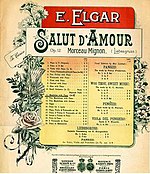Salut d'Amour

Salut d’Amour, Op. 12, is a musical work composed by Edward Elgar in 1888, originally written for violin and piano.
History
Elgar finished the piece in July 1888, when he was engaged to be married to Caroline Alice Roberts, and he called it "Liebesgruss" ('Love’s Greeting') because of Miss Roberts’ fluency in German. When he returned home to London on 22 September from a holiday at the house of his friend Dr. Charles Buck, in Settle, he presented it to her as an engagement present. Alice, for her part, offered him a poem called "The Wind at Dawn" which she had written years before and which he soon set to music.[1]
The dedication was in French: "à Carice". "Carice" was a combination of his wife's names Caroline Alice, and was the name to be given to their daughter born two years later.
It was not published (by Schott & Co.) until a year later, and the first editions were for violin and piano, piano solo, cello and piano, and for small orchestra. Few copies were sold until Schott changed the title to "Salut d’Amour" with Liebesgruss as a sub-title, and the composer’s name as 'Ed. Elgar'. The French title, Elgar realised, would help the work to be sold not only in France but in other European countries: Schott was a German publisher, with offices in Mainz, London, Paris and Brussels.
The first public performance was of the orchestral version, at a Crystal Palace concert on 11 November 1889, conducted by August Manns.
Arrangements
"Salut d’Amour" has certainly been published in more different forms and arrangements than any other work of Elgar’s.
As early as 1901, the list is substantial:


|
|
Many arrangements have been made since. For example, the song can also be found in Swedish as "Violer" ("Violets").
Recordings
- The first recording was made in January 1915, with Elgar conducting a 'Symphony Orchestra'. This acoustic recording was made for The Gramophone Company and appeared under the H.M.V. label, on disc D180.[8]
- New Light Orchestra (Victor Concert Orchestra Cond.: Rosario Bourdon). Recorded in New York City on September 4, 1929. It was released by Victor Records as catalogue number 4527B (in USA) and by EMI on the HMV Records label as catalogue number B 3926.
- Sarah Chang (violin) - Debut This 1992 CD recording includes Salut d'Amour
- Nigel Kennedy Chandos
- David Halen and Peter Henderson AAM 040102
- Kyung Wha Chung and Phillip Moll Eloquence #476755
- Julian Lloyd Webber with the Royal Philharmonic Orchestra on the CD Made In England
- Elgar Society Several recordings available
Performances on Video
A selection
- Alvaro Siviero Piano solo.
- Sarah Chang (violin)[9] Violin and piano.
- Joanna Westers (violin) Violin and piano.
- Clara Garde (violin), Marie-Benedicte Cohu (Piano) Violin and piano.
- Helen Cho (violin), Harold Wu (piano) Violin and piano.
- Young-nim Ma (violin), Miyang Kim (piano) Violin and piano.
- Valerie (9) (violin), Dominique(11) (piano) Violin and piano.
- Ferenc "Pepe" Mocsár (cello) and cimbalom Violin and cimbalom.
- A. Usami (flute) Flute and piano.
- Karen Constant (violin), Yleesh Constant (cello), Elena Semenets (piano) Violin, cello and piano.
- Danny Takagi (violin), Yumiko Moro-oka (cello), Mariya Ando (piano) Violin, cello and piano.
- Attila Lakatos (violin), Kriszti Magyar (flute), Ond Székely (cello), Kulcsár Janka (piano) Violin, flute, cello and piano.
- Li Chuanyun (violin), Pan Asia Symphony Orchestra Violin and orchestra.
- Daiske Nagamine (conductor), TSU Philharmony Orchestrea Orchestra.
- Harmonie Köln Mandoline orchestra.
Notes
- ^ Jerrold Northrop Moore has found resemblances between the two works
- ^ George B. Marchisio came to London from Italy and, from 1892 was professor of mandolin and guitar at Trinity College and the Guilhall School of Music. He arranged concert pieces for the guitar. The biography of Marchisio is from The Guitar and Mandolin by P. L. Bone
- ^ Charles J. Grey, organist and composer
- ^ Max Laistner (1853-1917) was a German musician, a concert pianist and director of the Max Laistner Choir. He made piano transciptions of the classics, including an "Etude de Concert" after Chopin's Valse in D-flat major "Minute Waltz"
- ^ Alice Chambers Bunten, scholar, author and lyricist for many songs, well-known for her Life of Alice Barnham, Wife of Sir Francis Bacon, London: Oliphants Ltd. 1928
- ^ Rizzelli wrote the lyrics to Arthur Sullivan's "Venetian Serenade - 'Nel ciel siren'"
- ^ Emma Klingenfeld (born 1846) was well known as a translator of Norwegian plays, folk ballads and songs
- ^ Kennedy, p.302
- ^ When violinist Yehudi Menuhin first heard Sarah Chang perform he called her "the most wonderful, perfect, ideal violinist I've ever heard." She started studying violin when she was four, and by the age of six, was the youngest-ever student at Juilliard.
References
- Kennedy, Michael, Portrait of Elgar (Oxford University Press, 1968) ISBN 0193154145
- Moore, Jerrold N. Edward Elgar: a creative life (Oxford University Press, 1984) ISBN 0193154471
